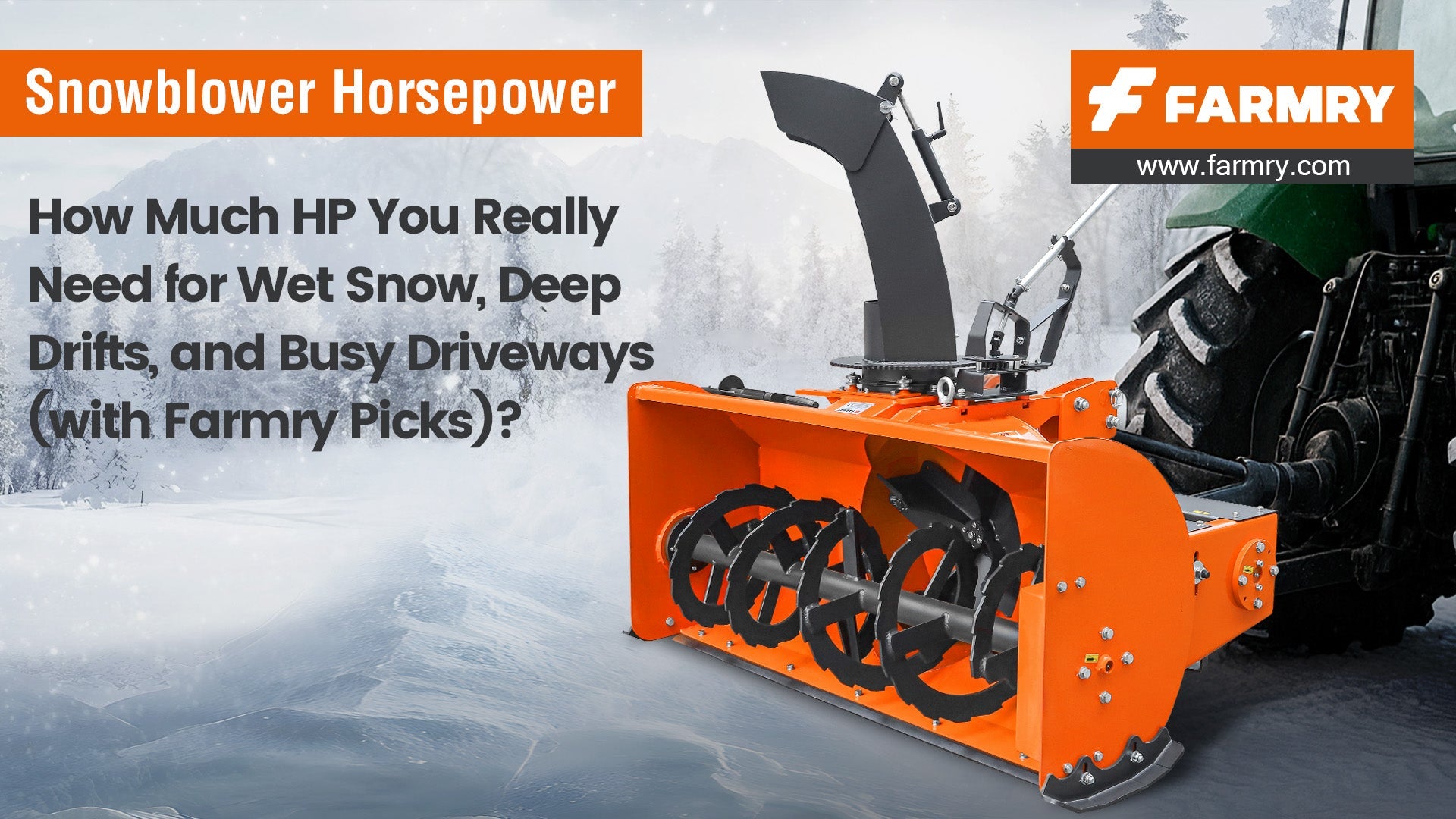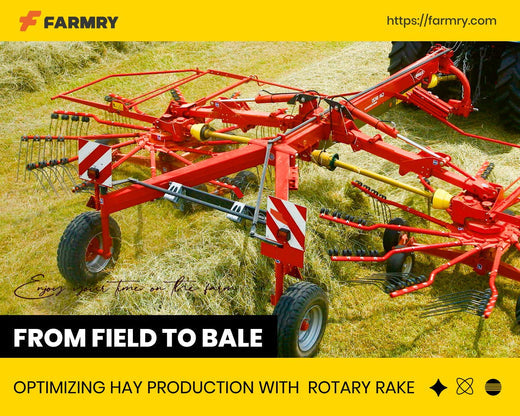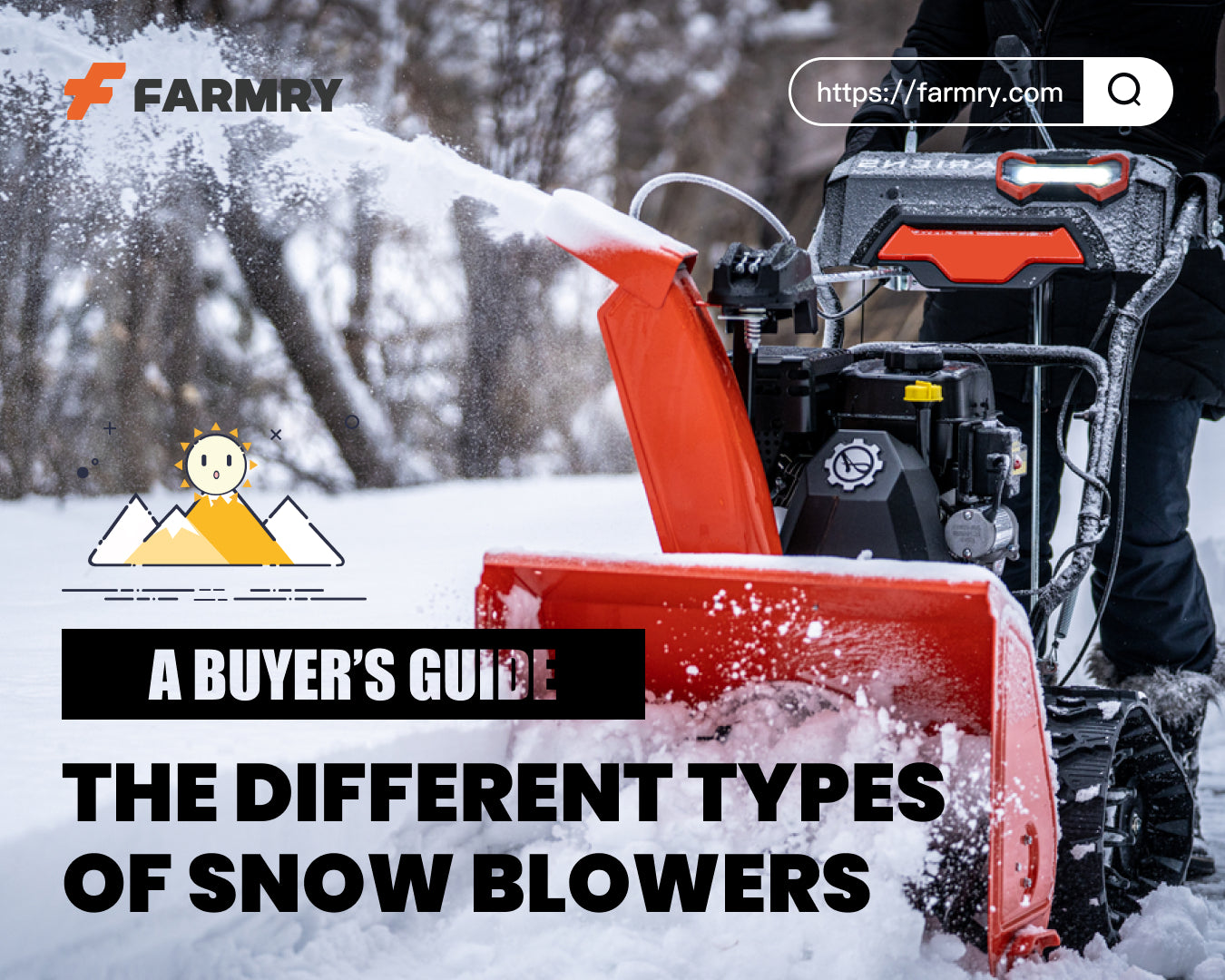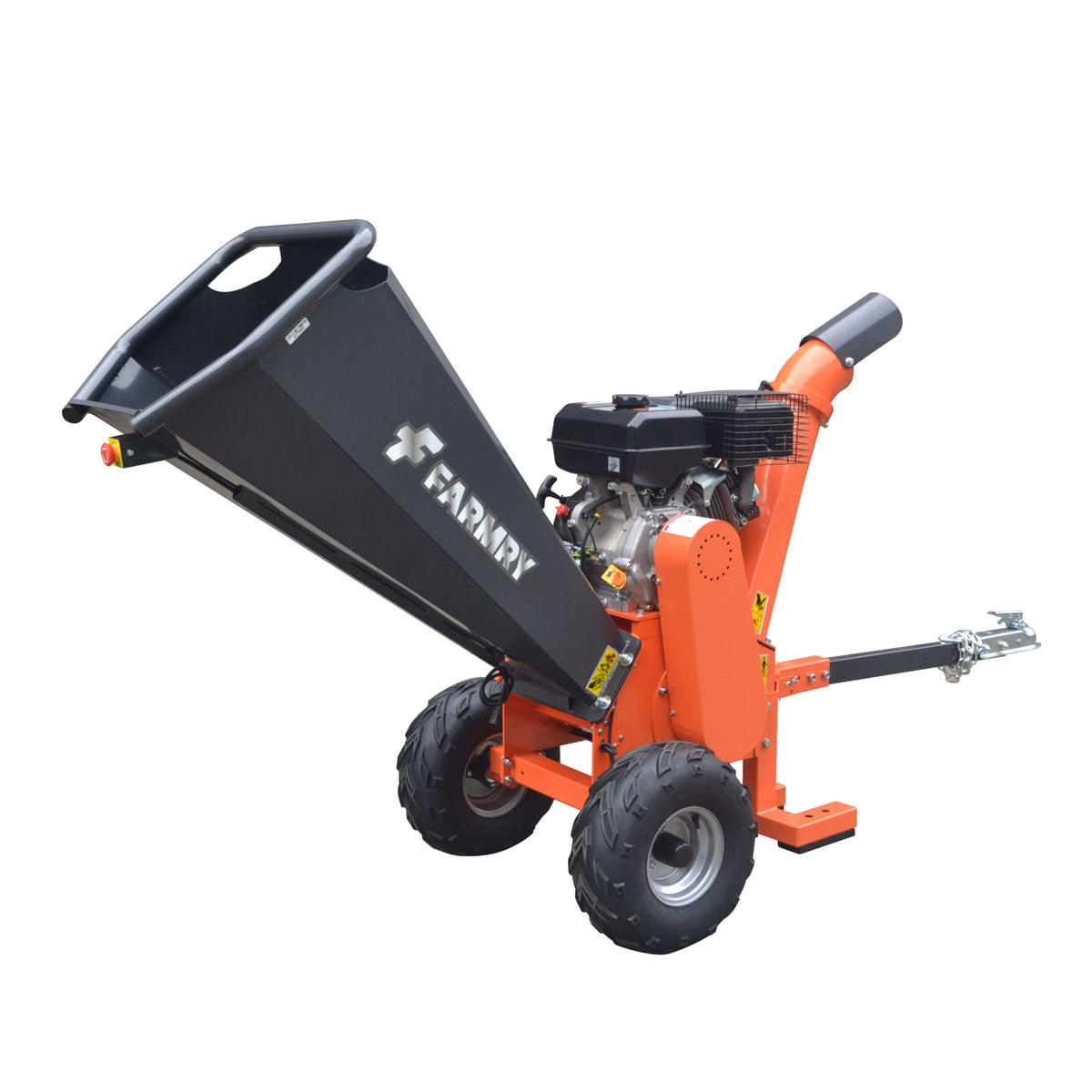Backhoe vs Excavator: How to Choose the Right Machine for Your Project (with Farmry Picks)
 At first glance, backhoe vs excavator looks like a simple either/or choice. But when your construction project depends on the right equipment, the difference between a backhoe and an excavator—and which one fits your job site—can make or break timelines, budgets, and outcomes. This guide breaks down the two machines in plain language, shows where each excels, and spotlights Farmry’s value-forward attachments and implements that help you do more work with fewer machines.
At first glance, backhoe vs excavator looks like a simple either/or choice. But when your construction project depends on the right equipment, the difference between a backhoe and an excavator—and which one fits your job site—can make or break timelines, budgets, and outcomes. This guide breaks down the two machines in plain language, shows where each excels, and spotlights Farmry’s value-forward attachments and implements that help you do more work with fewer machines.
Whether you’re trenching for utilities, cleaning up demolition debris, digging foundations, or tackling landscaping and material handling, you’ll leave with an informed decision on the machine for your project—plus a shortlist of Farmry gear to power through heavy duty tasks.
The Quick Take: What’s the Difference Between a Backhoe and an Excavator?
Backhoe
-
A multi purpose machine: a front loader bucket on the front and a digging bucket (the “backhoe”) on a two part articulated arm at the rear.
-
Shines on smaller projects and smaller scale digging with lots of various tasks in different locations during the same day.
-
Known for dual functionality—load, carry, backfill, and dig with a single unit.
-
The compact design and road speed make it easy to move between job sites without special transport.
Excavator
-
Purpose-built excavating equipment with a 360° rotating upper structure, long boom and stick, and a powerful bucket.
-
Typically larger than backhoes and built to dig deeper, move more earth, and offer more power and extended reach.
-
Well suited to larger projects, major industrial or industrial projects, large scale construction, mining operations, and demolition projects.
-
Most excavators need a trailer for transport, but mobility excavators (rubber-tired models) exist for rough terrain and urban moves.
In short: choose a backhoe for dual functionality and versatile, all-day switching among various attachments and chores. Choose an excavator when the project requires deeper, faster digging and lifting heavy materials at scale.
Backhoe Loader: The Swiss Army Knife of Job Sites
A backhoe loader pairs a loader bucket up front with a rear digging bucket. Backhoes feature quick switching between tasks: scoop gravel, backfill trenches, hoist pallets, then swing around and dig. On smaller machines—especially compact and sub-compact tractor platforms—this combo drives big productivity without big overhead.
Where a Backhoe Excels
-
Smaller scale digging and trenching for irrigation, utilities, and landscaping.
-
Material handling with forks or a loader bucket—moving mulch, stone, and large quantities of soil.
-
Day-to-day construction equipment duties on municipal or commercial projects where the team needs one unit to do various tasks.
-
Frequent moves across different locations where road speed matters.
Farmry Picks for Backhoe Productivity
-
Farmry backhoe attachments for compact and mid-size tractors: pair with the correct subframe or 3-point configuration for safe, heavy duty digging.
-
Farmry buckets and thumbs: increase grip for placing large objects (rocks, timbers) and sorting debris on demolition projects.
-
Farmry pallet forks and loader bucket upgrades: speed up material handling and staging on crowded job sites.
-
Farmry auger and trenching attachments: drill post holes, drop lines fast, and reduce hand labor on smaller projects.
Why Farmry? Cost effectiveness, accessible parts, and smart attachment bundles let you kit out one machine for a wider range of work. If you do more backhoes in your fleet, standardizing on compatible Farmry attachments keeps training and spares simple.
Excavator: The Specialist for Power and Reach
An excavator is the specialist that typically handle deeper cuts, faster cycle times, and heavy materials at volume. With various attachments—hydraulic thumbs, breakers, grapples, compaction wheels—excavators dominate larger machinery roles.
Where an Excavator Wins
-
High-production trenching and mass excavation where you must move more earth faster.
-
Demolition projects—especially with a breaker or shear—and sorting on industrial projects.
-
Lifting and placing large objects with precision thanks to superior hydraulics and extended reach.
-
Large scale construction, commercial projects, and major industrial sites with tight deadlines.
Farmry Complements for Excavator Crews
Even if your core is excavating equipment, a support tractor outfitted with Farmry attachments can front-load many tasks: move aggregate with a front loader, stage pallets, backfill after the excavator cuts, or maintain access roads with a Farmry box blade or grading scraper. That combo keeps the excavator doing what it does best: dig, swing, dump—repeat.
Backhoe vs Excavator: Capability by Capability
1) Digging Performance
-
Excavator: More power, faster cycles, and ability to dig deeper with big buckets. Ideal for basements, ponds, and long utility runs.
-
Backhoe: Strong enough for foundations on lighter builds, short utility lines, and digging holes for posts and trees. Great when you need the loader the same day.
Farmry tip: If your project includes both trenching and extensive backfill or material handling, a Farmry-equipped backhoe can keep your tempo high without bringing a second machine.
2) Reach and Swing
-
Excavators deliver extended reach and 360° swing, letting you dig without constant repositioning.
-
Backhoes have excellent maneuverability but shorter reach. You’ll reposition more often on larger projects.
3) Transport and Mobility
-
Backhoe: Often drivable between job sites without special permits, making it a nimble choice for crews bouncing among different locations.
-
Excavator: Trailer transport is common; mobility excavators (rubber tires) help in urban construction corridors and rough terrain.
4) Versatility & Attachments
-
Backhoe: The built-in front loader plus rear hoe give dual functionality every day. Add various attachments (thumbs, hitches, augers) and you get a true multi purpose machine.
-
Excavator: Takes a wider range of hydraulic tools—breakers for demolition, grapples for scrap, tilting digging bucket for slope work—great for heavy duty tasks and specialty roles.
Farmry advantage: A curated catalog of attachments for tractors and backhoe setups means fewer vendor headaches and easy part matchups across machines.
5) Cost Effectiveness
-
Backhoe: For crews juggling multiple small chores, a backhoe’s cost effectiveness is outstanding—compact design, fewer transports, and all-day usefulness.
-
Excavator: Higher acquisition and transport costs pay off on larger machinery workloads where production speed rules.
Use-Case Scenarios: Which Is the Right Machine?
Scenario A: Urban Utility Cut & Backfill
-
Needs: Tight street access, quick saw-cut trench, service tie-ins, backfill, and cleanup before traffic resumes.
-
Pick: Backhoe with Farmry forks, loader bucket, and a narrow digging bucket. The same unit can trench, set plates, and haul spoils. Backhoe vs excavator here swings to the backhoe’s dual functionality.
Scenario B: New Subdivision—Miles of Utilities
-
Needs: Long runs, repetitive trench depth, high production, constant truck loading.
-
Pick: Excavator. You’ll move more earth faster and lift heavy materials efficiently. Support it with a Farmry-equipped tractor for grading and backfill.
Scenario C: Estate Improvements & Landscaping
-
Needs: Smaller projects: tree planting, digging holes for fence posts, drainage swales, moving mulch and stone.
-
Pick: Backhoe. A Farmry post-hole auger plus loader bucket streamlines the whole punch list in one day.
Scenario D: Structural Demolition
-
Needs: Concrete breaking, sorting, and loading out heavy materials.
-
Pick: Excavator with breaker and grapple. A Farmry-equipped tractor can still shine in site cleanup and backfill as walls come down.
Scenario E: Farm Drainage & Ponds
-
Needs: Deep cuts, shaping banks, rough terrain.
-
Pick: Excavator if you need extended reach and depth. If the job also involves miles of material handling and road maintenance after digging, mix in a backhoe or a Farmry loader package.
Feature-by-Feature Checklist (Keep This Handy)
-
Depth & Power: If your project requires deep cuts or heavy duty digging, an excavator is well suited.
-
Task Switching: If you’ll load, carry, and dig multiple times daily, a backhoe is the perfect machine.
-
Transport: Frequent hops to different locations? Backhoe wins.
-
Attachments: Need breakers, shears, and advanced hydraulic tools? Excavators. Need a daily loader plus hoe? Backhoe.
-
Footprint: Tight sites and urban corridors may favor a compact backhoe or a small excavator; smaller size machines reduce disruption.
-
Budget: For cost effectiveness across various tasks, the backhoe generally pulls ahead. For high-volume production, the excavator’s output justifies the spend.
Farmry Product Pathways: Build a Lean, Capable Fleet
1) The Backhoe-Centric Crew
-
Start with a tractor-mounted Farmry backhoe (match reach and flow to your platform).
-
Add Farmry buckets, mechanical or hydraulic thumbs, quick-attach front loader tools (pallet forks, loader bucket variants).
-
For utilities and fencing: Farmry auger set for clean digging holes across soil types.
-
Result: One unit handles various tasks—load, trench, set, and backfill—ideal for smaller projects and mixed job lists.
2) The Excavation-First Operation
-
Keep your excavator cutting nonstop.
-
Pair a support tractor with Farmry blades, rakes, and material handling attachments to maintain pace, tidy spoil piles, and prep subgrades.
-
Result: The excavator focuses on heavy duty tasks while the support machine multiplies throughput.
3) The Municipal / Campus Utility Team
-
Standardize attachments so operators can move from machine to machine without confusion.
-
Use Farmry quick-change buckets, thumbs, and forks to reduce idle time.
-
Result: Higher uptime across projects with less specialized training.
FAQs: Speed Answers for Busy Builders
Q1. Is a backhoe or excavator better for my first machine?
If you juggle various tasks in one day—haul, grade, trench—the backhoe delivers unmatched dual functionality. If you mostly dig, lift, and swing all day, an excavator is your productivity champion.
Q2. Can a backhoe replace an excavator?
On smaller projects, yes—especially with the right attachments. But for larger projects or major industrial cuts, an excavator’s more power and extended reach are hard to beat.
Q3. What about demolition?
Demolition projects lean excavator due to breakers and grapples. Use a Farmry-equipped tractor for cleanup, material handling, and backfill.
Q4. How do I size the bucket?
Match digging bucket width to trench spec and soil—the wrong bucket kills cycle time. Farmry can help you align bucket geometry to your tractor or support machine.
Q5. Do I need multiple machines?
Not always. A well-equipped backhoe loader can cover a wider range of tasks. For larger machinery demands, keep the excavator digging and add a Farmry-equipped support unit.
The Bottom Line: Picking the Right Equipment with Confidence
Backhoe vs excavator isn’t about which is “better”—it’s about the right machine for your mix of tasks, budget, and mobility needs.
-
Choose a backhoe when you need dual functionality, compact design, and agility across different locations.
-
Choose an excavator when you need more power, extended reach, and production digging on larger projects.
With Farmry attachments and implements, you can elevate either path. Outfit a backhoe to behave like a mini-fleet, or support your excavator with a fast, affordable loader platform that keeps the dirt moving and the schedule tight. That’s genuine cost effectiveness—and a practical way to turn one machine into a job-winning system.
Ready to kit your machine? Share your tractor model, hydraulic specs, and the top three tasks on your next construction or commercial projects. We’ll map a Farmry bundle—buckets, thumbs, forks, augers—that meets your workload, keeps uptime high, and lets you move more earth, faster.







